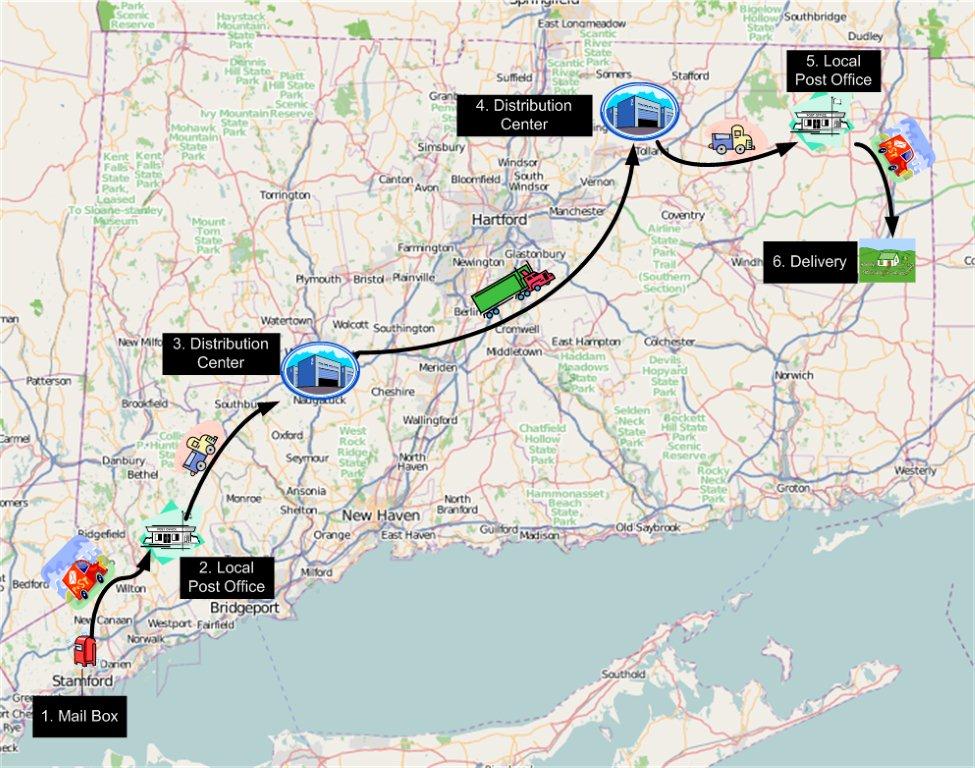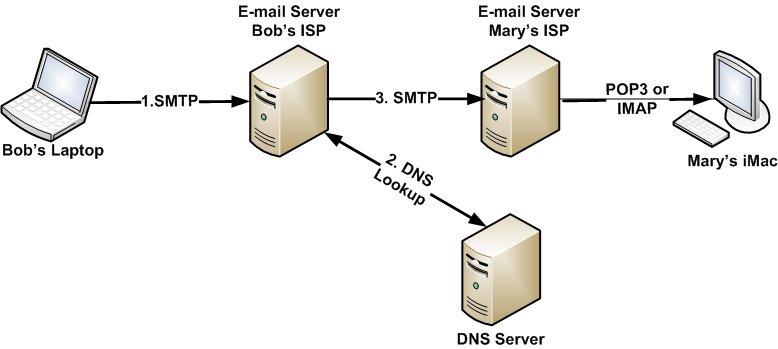How Email Works
A great way to understand how email works is to compare it to the mail service provided by the post office. Let's take a look at both of them and see how they get your message to your far-away friend.
How the postal service works
Once upon a time, and not so long ago - let's say, the early 1990s - if you wanted to send a letter to a friend you used the postal system. You got paper and pen; wrote the note (maybe going through multiple drafts); put the letter in an envelope; wrote the address on the envelope and stuck a stamp on it; and dropped the letter in a mail box. Then, the post office took your letter and carried it across town (or across the country or across the ocean) and delivered it to your friend. A simplified view of how postal delivery looks like this.
- You put the letter in a post box.
- A postal worker picks it up and takes it to the local post office.
- The letter goes from the local post office to a regional distribution center. It's sorted so that it goes to another distribution center that is near your friend's home.
- At the second distribution center, the letter is sent to your friend's local post office.
- The workers at the local post office sort the letter so that it goes in the truck that serves your friend's street or neighborhood.
- The post office delivers the letter to your friend's house.

As you can see, the letter passed through many hands to get to your friend's house. The reason that the letter was consistently directed to the right place was the address on the envelope. At each stop in the journey, the person or machine that scanned the address sorted the letter into the correct tray for its destination. If you wrote the wrong address or if the post office read it the wrong way, the letter may have been delivered late, delivered to the wrong address, or returned to you.
How email works
At first glance, email looks very different from the regular mail service provided by the post office. It's less physical. There's no one to pick up or deliver the letter, there are no large buildings for sorting and distributing it, and there are no big trucks for carrying it. However, there are similarities. Both mechanisms carry your same message and both require a delivery address for it. This time, though, that address is not the street address but the email address. And finally, there are rules that must be followed for your email to be delivered to your friend. Here's a basic view of how email delivery works.
- You send your email message from your computer to your email service provider.
- Your email service provider gets the destination address.
- Your email service provider sends the message to your friend's email service provider.
- Your friend gets the email from her service provider.

Like a real letter (or snail mail), an email goes through multiple stages to get from you to your friend. As it goes through these stages (called hops in Internet jargon), it uses several rules (known as protocols).
Software such as Thunderbird must follow these rules for email to be sent and received correctly. Some knowledge about these rules may be useful if you have to configure Thunderbird. Later on, you'll find out how these protocols affect the configuration of your copy of Thunderbird.
- SMTP
Simple Mail Transport Protocol - These rules handle outgoing email and get your email from your computer to your friend's service provider. - POP3
Post Office Protocol - These are the rules governing incoming email. It allows you to keep a set of messages on a server that Thunderbird can access and download to your computer. Once the email is downloaded to your computer, it is usually deleted from the server. - IMAP
Internet Mail Access Protocol - This is a different set of rules governing incoming email. IMAP is more sophisticated than POP3. It allows you to keep messages on a server that you can access from multiple computers. With IMAP, you can use Thunderbird to access an email account from home and Outlook to do this from work and still keep all your messages on the server.
The email address explained
Email addresses are made up of two parts that are separated by the @ symbol, something like john.doe@someplace.com. The first part, john.doe, is the name or alias of a person or organization. The second part, someplace.com, is the online location (domain name in Internet jargon) that is receiving the mail. The service provider's SMTP server uses a service called a Domain Name System (DNS) to find the domain on the Internet. Once the SMTP server has that information it can send the email to the recipient.
Parts of an email
An email message has two sections: a message header and a message body. You can think of the message header as the envelope of the email. It contains the address of the sender and recipient, the date the message was sent, and the title of the message. The body of the email is like the letter inside the envelope. The email writer uses Thunderbird to create both the header and the body by entering some information, including the recipients' email address(es), the subject line and the message itself. Other bits of information, such as the date and the sender's email address are all created by your email client or web mail application.





